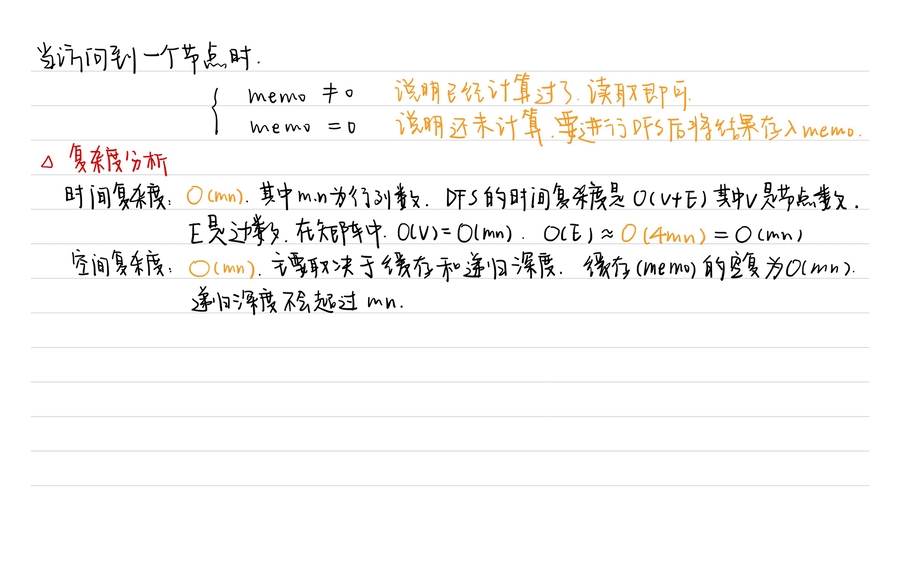LEETCODE 329. 矩阵中的最长递增路径
1. 问题
给定一个整数矩阵,找出最长递增路径的长度。
对于每个单元格,你可以往上,下,左,右四个方向移动。 你不能在对角线方向上移动或移动到边界外(即不允许环绕)。
示例 1:
输入: nums =
[
[9,9,4],
[6,6,8],
[2,1,1]
]
输出: 4
解释: 最长递增路径为 [1, 2, 6, 9]。示例 2:
输入: nums =
[
[3,4,5],
[3,2,6],
[2,2,1]
]
输出: 4
解释: 最长递增路径是 [3, 4, 5, 6]。注意不允许在对角线方向上移动。2. 解法 - DFS
2.1 Java
class Solution {
// 方向数组
public int[][] dir = {{-1, 0}, {1, 0}, {0, -1}, {0, 1}};
// 矩阵行列数
public int rows;
public int cols;
public int longestIncreasingPath(int[][] matrix) {
// 空矩阵直接返回0
if(matrix == null || matrix.length == 0)
return 0;
// 矩阵行列数
rows = matrix.length;
cols = matrix[0].length;
// 记忆数组,存储已经计算过的路径长度
int[][] memo = new int[rows][cols];
// 最终结果
int res = 0;
for(int i=0;i<rows;i++) {
for(int j=0;j<cols;j++) {
res = Math.max(res, dfs(i, j, memo, matrix));
}
}
return res;
}
// 计算第row行第col列节点的最长递增路径
public int dfs(int row, int col, int[][] memo, int[][] matrix) {
// 先判断当前节点是否计算过,如果计算过就直接返回结果
if (memo[row][col] != 0) {
return memo[row][col];
}
// 计算路径长度,自身+1
memo[row][col]++;
// 深度优先搜索 - 上下左右
for (int[] direction: dir) {
// 下一个节点的行列下标
int newRow = row + direction[0];
int newCol = col + direction[1];
// 如果节点的下标没有越界,且值比当前节点的值更大,那么就可以继续向深处搜索
if (newRow >= 0 && newRow < rows && newCol >= 0 && newCol < cols && matrix[newRow][newCol] > matrix[row][col]) {
// 比较memo[row][col]和继续搜索后得到的递增路径,更新为较大的路径
memo[row][col] = Math.max(memo[row][col], dfs(newRow, newCol, memo, matrix) + 1);
}
}
return memo[row][col];
}
}2.2 Kotlin
class Solution {
// 方向数组
var dir = arrayOf(intArrayOf(-1, 0), intArrayOf(1, 0), intArrayOf(0, -1), intArrayOf(0, 1))
// 矩阵行列数
var rows: Int = 0
var cols: Int = 0
fun longestIncreasingPath(matrix: Array<IntArray>?): Int {
// 空矩阵直接返回0
if (matrix == null || matrix.size == 0)
return 0
// 矩阵行列数
rows = matrix.size
cols = matrix[0].size
// 记忆数组,存储已经计算过的路径长度
val memo = Array(rows) { IntArray(cols) }
// 最终结果
var res = 0
for (i in 0 until rows) {
for (j in 0 until cols) {
res = Math.max(res, dfs(i, j, memo, matrix))
}
}
return res
}
// 计算第row行第col列节点的最长递增路径
fun dfs(row: Int, col: Int, memo: Array<IntArray>, matrix: Array<IntArray>): Int {
// 先判断当前节点是否计算过,如果计算过就直接返回结果
if (memo[row][col] != 0) {
return memo[row][col]
}
// 计算路径长度,自身+1
memo[row][col]++
// 深度优先搜索 - 上下左右
for (direction in dir) {
// 下一个节点的行列下标
val newRow = row + direction[0]
val newCol = col + direction[1]
// 如果节点的下标没有越界,且值比当前节点的值更大,那么就可以继续向深处搜索
if (newRow >= 0 && newRow < rows && newCol >= 0 && newCol < cols && matrix[newRow][newCol] > matrix[row][col]) {
// 比较memo[row][col]和继续搜索后得到的递增路径,更新为较大的路径
memo[row][col] = Math.max(memo[row][col], dfs(newRow, newCol, memo, matrix) + 1)
}
}
return memo[row][col]
}
}3. 参考
4. 笔记


最后更新于
这有帮助吗?